| Home > Policy > White Paper, Notice, Announcement > White Paper > WHITE PAPER ON SCIENCE AND TECHNOLOGY2003 > Part1 1.3 1.3.1 1.3.1.3 | ||
If excellent research results are to be obtained from a small number of researchers,individual researchers must be able to demonstrate their capabilities to the utmost.To help researchers fully demonstrate creativity,development of a suitable environment is needed.When researchers have an environment that allows them to fully demonstrate their creativity,then the workplace can become an appealing place for researchers,and top-level researchers can be attracted.
In the research environment,research expenses and development of facilities and equipment for research are important.While the"Second Science and Technology Basic Plan"promotes various environmental developments for reform of science and technology systems,here follows a discussion of problems that focus mainly on human resources.
| (1)Improving Mobility of Human Resources and Construction of Competitive Environment (Problems of Mobility) |
Japan's research community is said to have less mobility than Europe or North America.A research community with low mobility makes it difficult for a creative researcher to move to better compensation and a better environment suited to the person's results and aptitude,and therefore impedes demonstration of the researcher's creativity.Moreover,improved mobility is considered to be important for securing a wide-ranging education for researchers.Furthermore,with the increasing emphasis seen in recent years on interdisciplinary science and technology,much new knowledge appears to be arising from interaction between diverse opinions and diverse specialties.Improved mobility,then,can be considered essential for improving the vitality of research organizations by bringing together human resources from diverse backgrounds.
Figure1-3-32 shows the results of a survey on the number of institutions a researcher has had experience working for.As can be seen,more than half of the researchers surveyed have worked at just one institution in their career,revealing the low mobility of researchers.
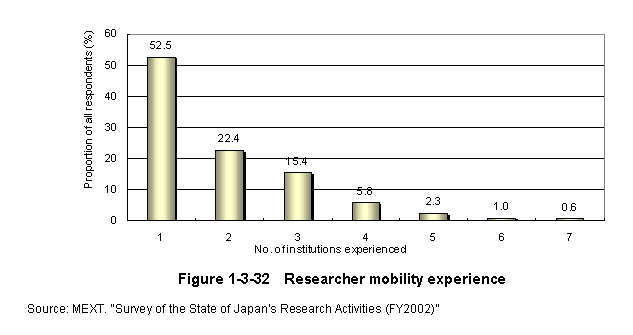
For researchers who had worked at two or more institutions, Figure1-3-33 shows the proportion of respondents who reported having good experiences at those institutions.The percentage reporting favorable items tended to decline with more moves and more institutions experienced.While it would be expected that one benefit of mobility would be the process of matching a researcher to the most suitable research environment,it was only with the second institution that an increasing number of respondents believed that the research environment was good.After that,the proportion of researchers with good impressions of their research institutions did not increase further,regardless of how many institutions they experienced.Respondents with experience at more institutions were less likely to list such favorable evaluation items as"treatment in terms of salary,welfare,etc."and"presence of excellent leaders."The latter item was no doubt selected less often because researchers who have moved often will also be older,and will therefore be shifting from follower to leadership positions.On the other hand,although it would be expected that"treatment in terms of salary,welfare,etc."are more attractive to older people,the survey actually discovered a decline in interest.These results,then,seem to show that,in Japan,people are not changing research institutions so much for better compensation or for better environmental conditions,but because they were compelled to move for other reasons,and that their level of satisfaction tends to decline the more often they move.
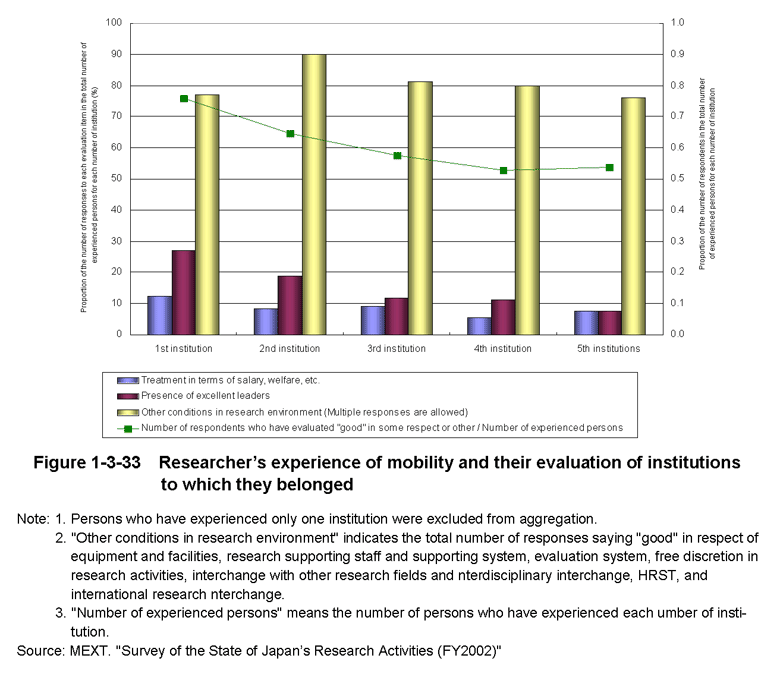
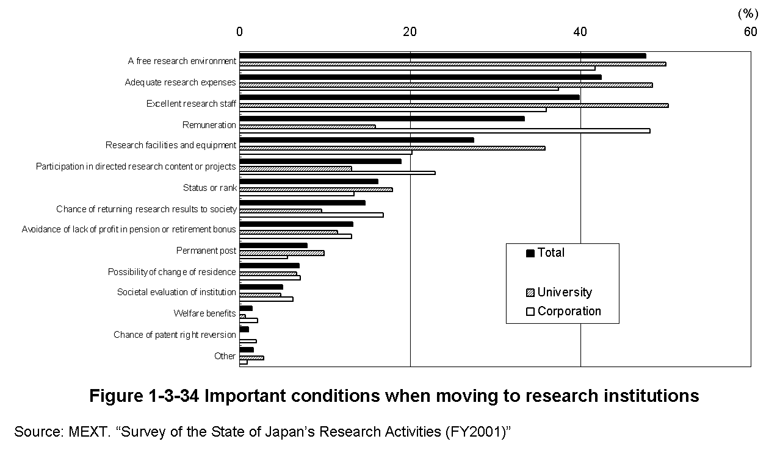
When the survey asked the conditions that researchers believe to be important when moving to another institution to conduct research,the most common responses were"a free research environment,""adequate research expenses,"and"excellent research staff."Many university researchers selected"research facilities and equipment,"while researchers at private-sector enterprises responded with"remuneration" (Figure1-3-34) .
The questionnaire asked researchers asserting that mobility is unnecessary to give reasons why they believed so,and64.7%of respondents selected"social system is a burden because of inadequate preparation."("Survey Regarding Effects and Issues of Japan's Science and Technology Policy,"published in March2000.See FY2001 Annual Report on Promotion of Science and Technology.)At present,people who change jobs are disadvantaged by the social system in terms of retirement bonuses,pensions,and other benefits,a situation that certainly militates against researcher mobility.A social system that provides support for mobility is needed.
| (Problems of Internal Recruitment in Universities) |
Compared to universities in the United States,a higher proportion of universities in Japan rely on internal advancement of people coming up through the school.As can be seen in Table1-3-35 ,about60%of the professors at graduate schools,which play a particularly important role in training researchers,also trained at those same schools.In the United States,by contrast,the proportion of professors coming from within the school is low,at only around20%of assistant professors for the University of California,for example (Table1-3-36) .In the United States,all universities and research institutes recruit very broadly for researchers,and hiring is based firmly on capability and competition.
Table1-3-35 shows percentage of professors who trained at their university at some stage in their educational career,including professors who moved on to a graduate school at a different university after graduation from their university department or to a different institution for post-doctoral work.Meanwhile,the FY2002"Survey of the State of Japan's Research Activities"found that114people,or about23%of the responding university researchers have worked only at the same university where they had completed their educational career since graduating.Of this group,96people did not have experience at any other university during their educational career,constituting about20%of the responding university researchers.

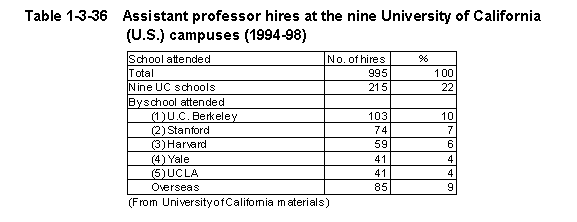
In general,since research organizations are considered to be able to demonstrate high levels of creativity only when they have an environment where diverse human resources can rub up against each other,it can be pointed out that universities where internal advancement is common are hindering the chances for their researchers to exchange ideas with diverse human resources,and that such a situation will lead eventually to a decline in creativity.When universities hire assistant professors or other staff members,they need to decide on their own initiative to increase hires of post-doctorals who have accumulated a variety of different experiences at other research institutions,and to actively seek people who have not risen through the school's own ranks.
| (Problems of the Fixed-Term Recruitment System) |
To improve mobility,a fixed-term recruitment system for younger people is being expanded(see3.3.1.1(2)).Moreover,incorporation of national universities has broadened discretion in the hiring of personnel,opening up still more possibilities at universities for the future promotion of efforts to boost mobility and diversity in fixed-term contract employees. Figure1-3-37 shows results from an annual survey of researchers regarding problems with the fixed-term recruitment system.In the survey results for FY2002,nearly two-thirds of respondents(64.1%)indicated that"institutions to receive upon expiry of the term are not prepared yet."Other common responses included"Research environment is not prepared yet to yield results in a short period"and"social security system during and after the term is not pre-pared yet."Moreover,the results of the FY2001 survey,while coming from different response choices,showed similar responses.There has not been much change in researcher awareness over the past three years,and it is difficult to see any progress in understanding of the fixed-term recruitment system.While researchers continue to point out such problems as an inability to find the next place of employment after the end of a limited term,or failure to prepare a proper environment for achieving results in a short period of time,there were slightly fewer respondents than earlier years who mentioned the inadequacy of the social security system or insufficient salaries and other compensation,a trend that perhaps reflects some progress toward transition from the seniority-based promotion system to a performance promotion system,introduction of a pre-payment retirement bonus system,and adoption of a defined contribution pension plan(a Japanese-version401k),particularly in private-sector enterprises.
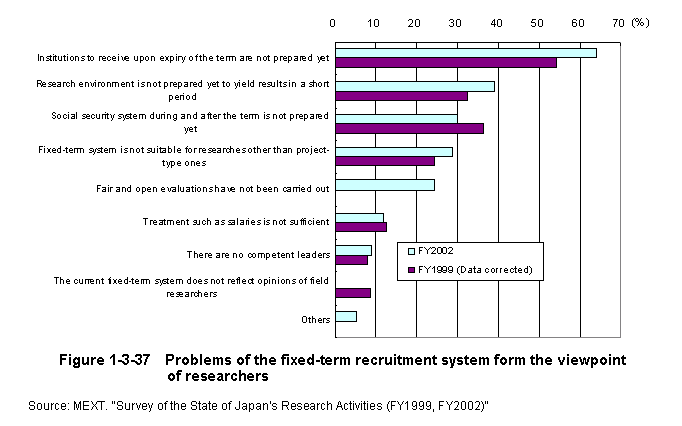
Certainly,situations where mobility is directly associated with employment instability will stifle expectations for creativity.The problem of a lack of available work after a term is complete probably can be placed on generally low mobility overall,with a few select organizations exhibiting mobility through the use of fixed-term contract researchers.As a result,there is a need to boost mobility still more,and for further reforms toward a science and technology system founded on the premise of mobility that helps people to find the best environment for self-improvement.
| (Competitive Environment to Encourage Creativity) |
Researchers were asked to compare the competitive environments of Japan,the United States,and Europe,and47%responded that Japan is not competitive compared to the United States,while29%said Japan is not competitive compared to Europe (Figure1-3-38) .Moreover,53.3%of researchers with research experience in the United States said that Japan is not competitive compared to the United States.
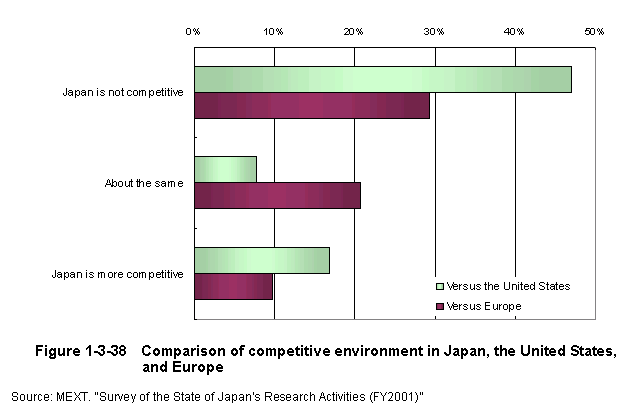
Universities in the United States have the tenure(life employment)system(see Column),and the career path for researchers is situated in an extremely competitive environment.Even people who succeed in securing tenure often do not receive salary from the university during periods when they are not actually teaching classes(not functioning as an instructor),and must secure outside funding,forcing them to concentrate on research so that they can present research results that prospective outside patrons will notice.Furthermore,they constantly look for greater freedom in research activities or improved compensation,expressing interest in recruitment from other universities that occasionally results in a change in employment.A transfer to a different university means that the researcher has been recognized by outsiders,and universities may try to secure the researcher by promising salary promotions,qualification promotions,and expanded research space.
The university instructor system in the United States,where high-quality research is performed in great quantities,and which holds a huge lead over the rest of the world in the science and technology sector,is very different from Japan's system. In Japan,the normal path for a researcher completing graduate school is to work as an assistant,and then rise up the ranks to instructor,assistant professor,and full professor,at which time the person is at last given control of a research laboratory.Appointments and promotions require the approval of the faculty. In the United States,by contrast,the person completing graduate school first gains experience as a research fellow,etc.,and then moves on to work as an instructor,assistant professor,etc.Unlike work in Japan,however,the person is first employed under a one-year contract,and has the contract renewed on a yearly basis,subject to examinations.After accumulating experience for three to seven years as an assistant professor,the person becomes an associate professor,and then secures tenure(right to lifelong employment)if he or she can pass the examination process to earn lifetime employment at that university.A starting position that leads several years down the road to a tenure examination is called a"Tenure Track"position. Examinations in the United States'competitive environment are tough,and the tenure examination process usually includes an interim examination.Furthermore,the final examination includes documentary preparation of past research performance,grants(research subsidies)received,and teaching experience,recommendations from outside academia and from randomly selected students,a speech in the academic department regarding aspirations after securing tenure,and a vote by all tenured professors,after which the tenure investigation committee makes a decision.The conditions for securing tenure are,in general,(1)skill as a researcher(quality of research:research papers and publications,performance securing government grants,outside evaluations from the same research sector)(2)skill as an educator(quality of teaching),and(3)skill at contributing to the university. Once tenure has been achieved,the person is given as much as six months to one full year every seven years(sabbatical leave)to engage in self-studies.During this period,the person is completely freed from teaching responsibilities and university committees,and can even go to other universities to freely pursue his or her own research. One area where the U.S.research system differs greatly from Japan's is the employment of assistant professors who do not have lifetime employment,and their appointment to their own research laboratories from the first tenure track position so as to be able to engage freely in their own research.On the other hand,in many cases the university pays them salaries only for the actual teaching period(nine months),so that they must search on their own for grants or other funding for the remaining months of the year.This system,which provides a free research environment that boosts researchers'desire to succeed,brings vitality to research and development activities,and gives rise to original research results,can be considered one of the forces powering the United States'world lead. |
Figure1-3-39 shows the average salary,highest salary,and lowest salary for university teachers in the United States,from a survey taken by the American Association of University Professors.According to this survey,the top salary for a full university professor is144,700U.S.dollars(about17.58million yen),while the lowest salary is34,800U.S.dollars(about4.23million yen).For assistant professors,the high and low figures are92,700U.S.dollars(about11.26million yen)and25,700U.S.dollars(about3.12million yen).
As can be seen,compensation for university professors is highly varied,with a difference of more than four times between the highest and lowest salaries.Even differences in salary for professors of the same age and level do not so much engender feelings of unfairness or dissatisfaction as to motivate people to look for a better working environment.
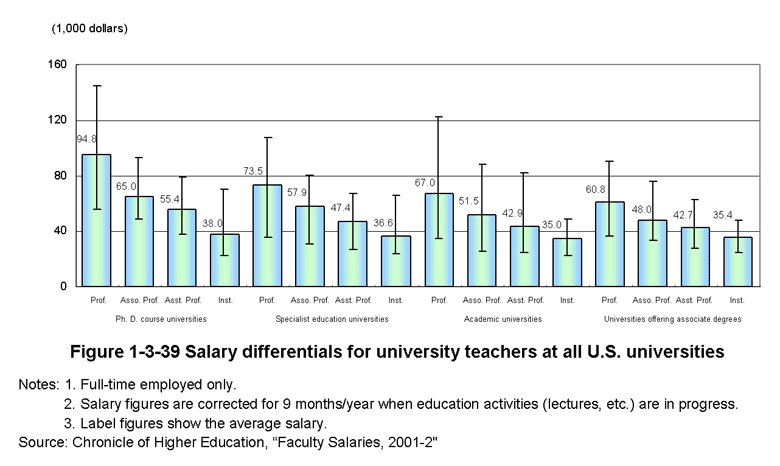
| (2)Young Researchers Maximizing Creativity |
A look at the ages of Nobel prizewinners when they first announced the achievements(scientific papers,etc.)that led to the Nobel award reveals ages of35to40for physics,and medicine and physiology,and ages of30to35for chemistry(see the FY2000 Annual Report on Promotion of Science and Technology).These results make clear that many of the most unique and knowledge-yielding research results arise from"young"researchers in their30s and early40s.Some of the conditions considered necessary for bringing out and stimulating creativity in young researchers include association with a good leader and an environment that encourages challenges in the face of failure.In addition,securing a variety of experiences in a broad range of fields while young is also considered effective in stimulating creativity.
| (Importance of Support to Post-doctorals) |
The post-doctoral period of a researcher's career path includes gaining experience under various leaders,searching for the most compatible research environment,expanding research horizons,and seeking challenges in new fields,thereby constituting a critical period in nurturing the creativity of young researchers.
Fostering and securing top-level researchers requires improvement of the independence of young researchers,and encouragement of excellent young researchers to maximize demonstration of their skills.To this end,the"First Science and Technology Basic Plan"(1996)announced the formation of the"10,000Post-doctorals Support Plan"and created and promoted various support programs for post-doctorals,etc.The goal of10,000graduates under the support plan was reached in FY1999,and the plan contributed to the creation of a strong group of young researchers in Japan,and to the construction of an environment that allows post-doctorals to concentrate solely on research.As of April1,2001,there were1,609special researchers(PDs)receiving support from the Japan Society for the Promotion of Science.
The use of competitive funding for employment of post-doctorals is also increasing.Institutions operating under the jurisdiction of the Ministry of Education,Culture,Sports,Science and Technology use various forms of competitive research funding to employ1,175people(in FY2001)in projects related to basic research and R&D.In the ministry's"Survey of the State of Japan's Research Activities(FY2002),"about13%of respondents claimed to have post-doctorals in their research labs and research groups.
Many researchers hold negative images of post-doctorals.As shown in Figure1-3-40 ,the researchers that post-doctorals'"positioning as researchers is vague"they have"not socially recognized yet,"and they are just a"a saucer for receiving the oversupply of doctors."
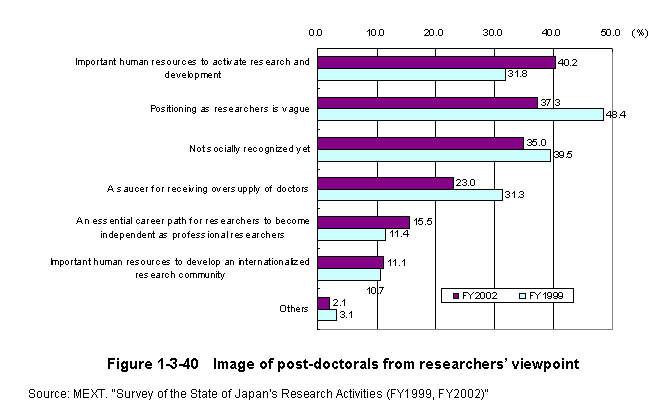
When compared to a similar survey conducted in FY1999,however,negative responses have decreased more than the above survey,and positive responses,such as post-doctorals are an"important human resource for revitalizing research and development"have increased.These responses show that the existence and significance of post-doctorals,and the roles they can play,are slowly but steadily gaining more attention.Moreover,post-doctorals are receiving slightly more recognition as taking a career path toward independence as a professional researcher.
| (Grants-in-aid for Scientific Research to Young Researcher) |
Figure1-3-41 shows the results of an awareness survey targeting researchers,regarding research expenses(competitive funding,project research,basic expenses,etc.)at the researchers'own discretion,by age group.As can be seen in the figure,the proportion of people with discretionary authority(people with discretionary research funds greater than zero)to all respondents was about the same for ages35to59.By contrast,the proportions showed large disparities by age when respondents reported the total value of their discretionary expenses,with more than40%of the total research expenses controlled by the discretionary authority of researchers aged50to54.In addition,the value of discretionary expenses per capita was highest for the group aged50to54,at about85million yen per researcher,as opposed to less than10million yen per researcher for the under-40group.Furthermore,the proportion of people with discretionary authority(people with discretionary research funds greater than zero)was more than80%of the total for respondents aged40to65,as opposed to less than60%of the total for the under-35group.These results show that a relatively large percentage of young researchers do not have free disposition of research expenses,and even if they do have control of fund disposition,the amounts are relatively small.While young researchers do not necessarily always require large amounts of research expenses,expansion of support for young researchers is an important issue in terms of assuring their independence.
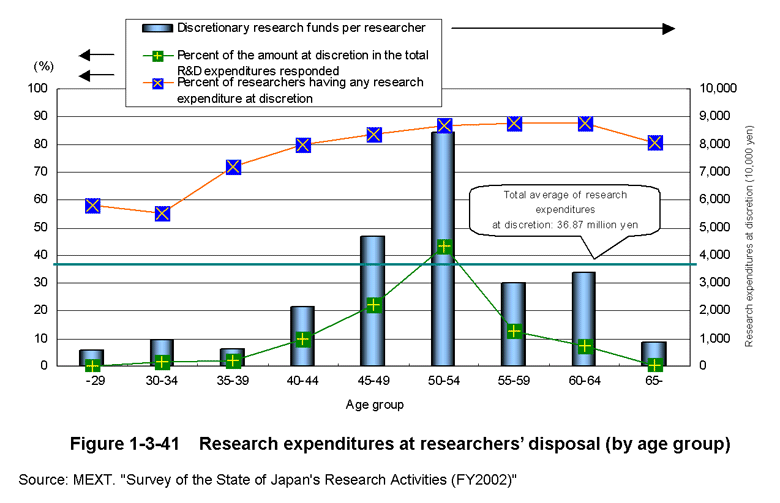
Reserving a portion of competitive funding for the use of young researchers is an effective way to support young researchers who,though not having a performance history,are recognized for their excellence and can be expected to conduct independent research using their own concepts.A competitive funding program targeted at young researchers in Japan is shown in Table1-3-42 .
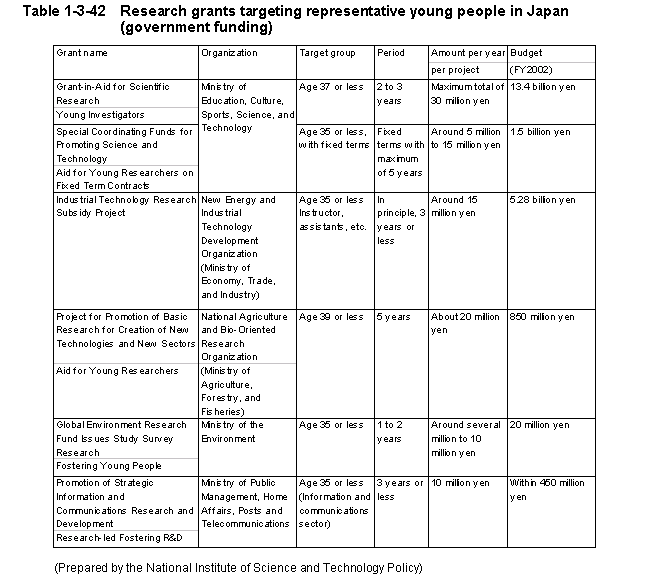
(Prepared by the National Institute of Science and Technology Policy)
A look at applicants(research representatives)for new topics under the"Grant-in-Aid for Academic Research Program,"a representative example of competitive funding in Japan,reveals that applicants in the relatively young30s age group were not at all inferior to other age groups in the number of topics chosen (Figure1-3-43) .This result can be traced to the establishment of the Grant-in-Aid for Scientific Research Program's cource for targeting young researchers aged37or less.Such competitive funding programs targeting young researchers are believed to be contributing to the provision of opportunities for securing the independence of young researchers.
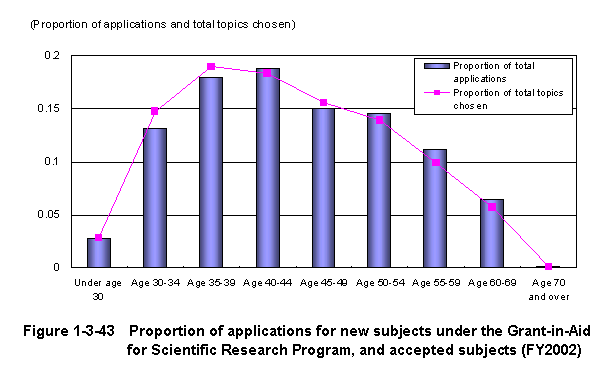
In the United States,because similar representative competitive funding programs are not allowed to discriminate on the basis of age,as with gender or race,and also because of the high mobility of society in general,applicants are targeted by number of years of research experience rather than by age (Table1-3-44) .This approach ensures that researchers who have returned to graduate school at an advanced age after a period out in society,researchers in other fields of study,and other diverse research personnel,can also be targeted for support.
| (Measures to Promote Internationalization of Young Researchers) |
Personal networks built up through international exchanges of researchers lay the foundations in support of international research cooperation and exchanges,and promotion of researcher exchanges can be considered an important issue in promoting internationalization.The percentage of Japan's joint authorship of scientific papers with foreign researchers is the lowest among OECD countries (Figure1-3-45) ,and more efforts need to be exerted in promotion of international cooperation and exchanges.
Figure1-3-46 shows the trend in the number of Japanese researchers going overseas,by region.As can be seen,the number going overseas has risen each year,and international mobility has increased.By region,more than two-thirds of the total went to countries in Europe and North America,with about40%going to North America and about30%going to Europe.In recent years,however,the number of people going overseas has leveled off,and growth has been slight.
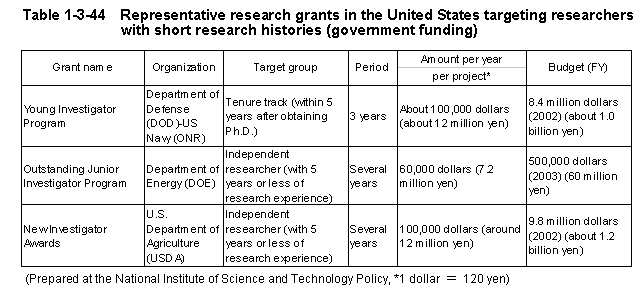
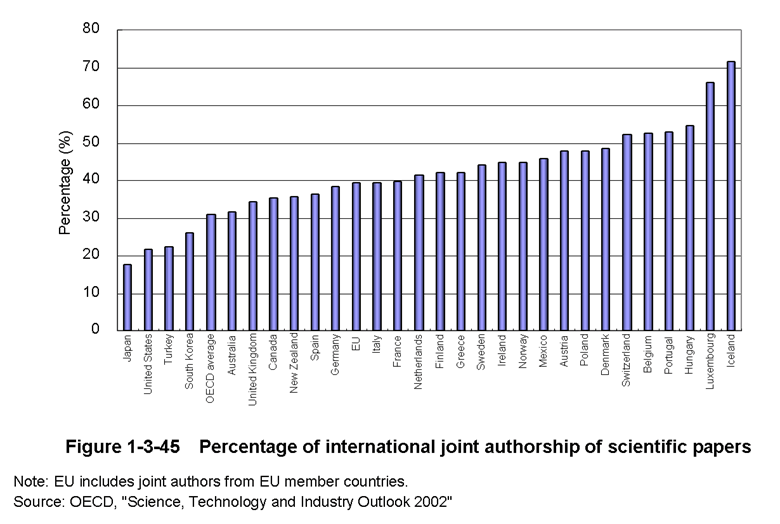
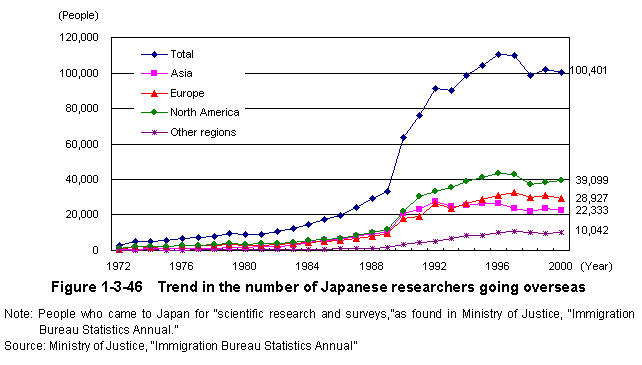
While the number of Japanese researchers going overseas has been rising,opportunities for long sojourns at foreign universities and research institutions,and for study while engaged in daily interactions with foreign researchers,have not expanded.In fact,"On Policy for Promoting the Internationalization of Scientific and Technological Activities,"a report released on January15,2003,by the Internationalization Promotion Committee of the Science and Technology Council,reports that the shrinking size of programs in European and North American countries for hiring or inviting post-doctorals is actually resulting in fewer such opportunities.Research experience overseas is extremely important for promotion of world-class research,and the need for nurturing top-level researchers makes it imperative that long-term overseas research for young researchers be actively promoted.
The FY2002"Survey of the State of Japan's Research Activities"conducted by the Ministry of Education,Culture,Sports,Science and Technology,found that524respondents had some sort of experience with research activities overseas,only about39%of the total respondents.In Japan's case,low researcher mobility means that Japanese who have gone overseas may find that returning to Japan is not easy.Most people with overseas research experience go abroad through dispatch from their resident institution in Japan.In fact,90%of the respondents who said they had overseas experience knew on the date of their departure that they would be returning to Japan.Of those respondents who went overseas without knowing where in Japan they would be returning to,many said they placed priority on finding a workplace in Japan because of the quality of the daily living environment,and the research environment where researchers can settle down to study.Moreover,many researchers who currently live overseas apparently would like to work in Japan but have not returned home because they cannot find a suitable post.Promotion of mobility would open up a more welcoming environment for people with overseas experience,and effecttively bring their valuable overseas experiences back for the benefit of Japan.
| (3)Expansion of Research Support System (Improvement of Environment Allowing Researchers to Concentrate Solely on Research Activities) |
The research support system at science and technology R&D sites in Japan has long been considered to be inadequate.Performance of creative research requires the development of an environment where researchers can concentrate on research,through provision of research assistants,administrative personnel,and other elements of a research support system.Japan provides0.29research support staffers per researcher,less than half the standard in other major countries(France:0.96,Germany:0.88,United Kingdom:1.00).In view of the fact that Japan had0.57research support staffers per researchers figure in1992,the number has actually declined by half in just10years,to0.29in2002.
A survey into the shortage of support personnel for science and technology found that respon-dents reported a general shortage among research support staff(research assistants,technicians,and research administrators),with respondents from universities and public research institutions,in particular,calling it a"shortage of both quality and quantity" (Figure1-3-47) .
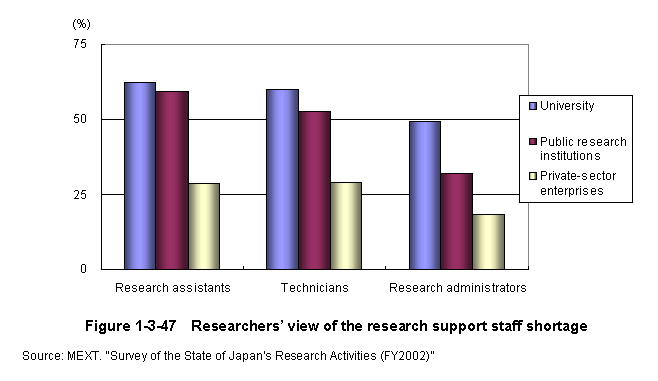
Figure1-3-48 shows the results of an awareness survey that targeted researchers,asking what factors in their current research environment hinder their research.The survey,which asked respondents to select"hindering factor"or"not hindering factor"for various research conditions,found that respondents saw"number of research personnel"and"capabilities of research personnel"as major factors hindering their current research.These results hint at the existence of shortages in human resources in both quantity and quality.Many of the respondents also put"development of research support staff"at the same level as"capabilities of research personnel."These results also point out shortages in research personnel and the need for research support.
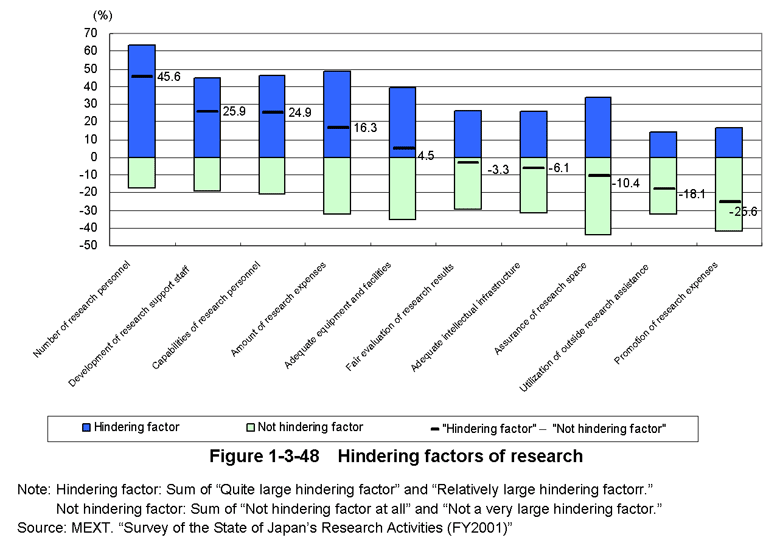
Figure1-3-49 shows the results of an awareness survey of researchers regarding the appeal of research activities overseas.The survey found that more than70%of respondents agreed that performance of research overseas holds appeal because"the environment eliminates miscellaneous chores to allow concentration on research."This result shows that,in Japan,the lack of a good support system is preventing people from concentrating on research.Together with the above awareness survey on factors that hinder research,these results show the need for both quantitative and qualitative development of research support staff,and for development of a better research support system.
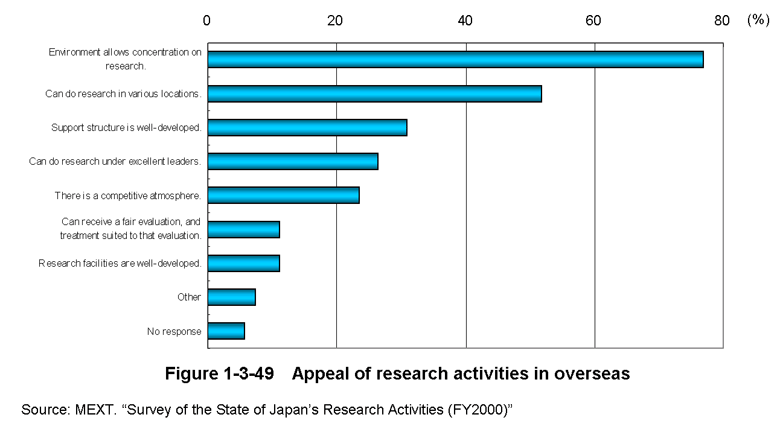
Over the years,various measures have been adopted to strengthen the research support system,including the Research Assistant Program in national universities,etc.,which seeks participation by doctoral students as research assistants,the Research Support Promotion Fellowship Program,which offers the services of outside people with special skills,and the establishment by the Japan Science and Technology Corporation of the Priority Support Cooperation Fellowship Program for independent administration research institutions.However,more efforts are needed.Regarding the supply of research support staff,there is a need for flexible utilization of outside human resources,including the dispatch of labor to project sites when research activities and support administration require it,and for training of human resources over the long term where there is a continuing need for special technologies and skills.
Meanwhile,a failure to establish a career and skills structure for research support operations is believed to be making it more difficult to assure the supply of human resources for these operations.According to the results of a questionnaire survey targeting research management,the main problems with personnel compensation for technological research support staff include"low salary standards when compared to researchers"and"failure to reflect special skills and expert knowledge in personnel evaluations" (Figure1-3-50) .Resolution of the research support staff shortage problem will require suitable compensation for skills and performance,and creation of work environments that help research support staff feel proud about their work.
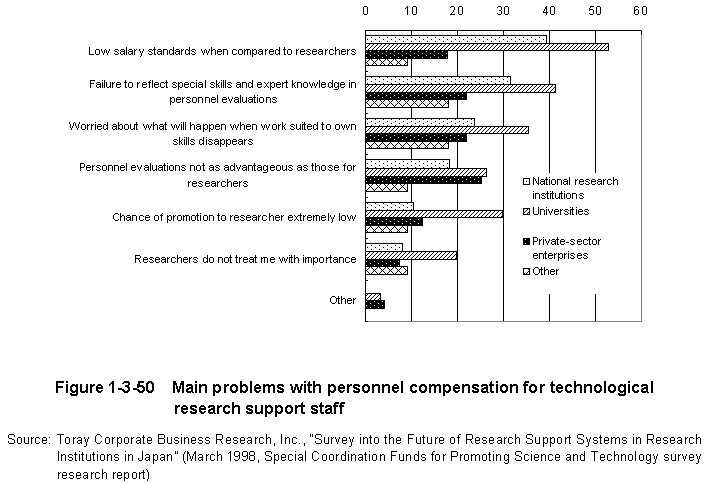
| Back to Top | MEXT HOME |